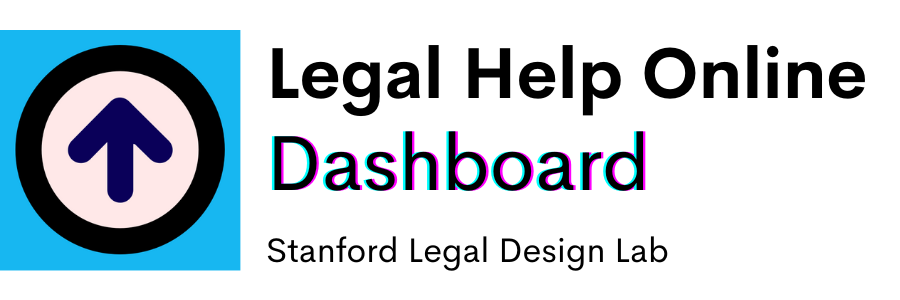Make excellent, user-friendly legal help websites.
How is your court, legal aid, or law help portal performing? Use the Legal Help Online Dashboard to review and improve your legal help website.
The Legal Help Online Dashboard gives you best practices, rankings, tools, and audits to make a legal website that people can find & use.
People working for a court, legal aid group, law library, or law help site can use these free resources to improve their legal help website.

Use the Legal Help Online Dashboard to rank your website. How is your site doing on the 4 key areas: Discovery, Tech, Content, and Design?
Use our rankings to understand how you are doing.
Then use our guides to improve on all 4 areas, and serve the public better.

Join our Legal Help Online Cohort
We host a Legal Help Online Cohort that coordinates legal help administrators & justice technologists.
The Cohort meets monthly & has an ongoing Slack group to share best practices, learn of new innovations, and build a cross-jurisdiction community
Join us! We are happy to support you in making an excellent legal help website.
You will get technical assistance and a supportive community in making your legal help website better & show up higher on search engines.
Guides to Make Your Legal Help Website Better
Ready to improve your website? Get started with 4 key areas: Discovery, Tech, Design, and Content.
The Legal Help Dashboard will walk you through reviews on each area, and then strategies to improve on each.
Explore Our Data on Legal Help Websites & Needs
Our group at Stanford Legal Design Lab is compiling data to help courts, legal aid groups, and others track what websites are offering legal help, what needs there are, and how different sites and Internet platforms are doing.
Explore our data to understand more about legal help online.

Monthly Visitors to Legal Help Websites
Check to see estimates, as of 2021, of how many people are visiting different legal help websites to get help.

Proportions of Needs a Legal Help Website Serves
How many of a jurisdiction’s justice needs is a website serving? How much of the public are they connecting with? This data presents the proportion of website visits compared with the local population with legal needs.

What are the most common legal problems that people ask for help with online? We are gathering recent data on Reddit & online legal clinic data to see the most common issues that people have.

Tech Performance of Legal Help Websites
Is a legal help website built well? Does it follow best practices around technical accessibility, security, bugs, speed, and stability? Find the rankings and specific action items for sites.

Master List of Legal Help Websites
What are all of the legal help websites that offer help to people in the US? Our group has been compiling this ‘supply’ list, including both commercial and public interest websites.

What are standard ways to reference the legal issues that a person might experience? We have built the Legal Issues Taxonomy (LIST) to have machine-readable, standard codes for the problems people experience & lawyers can help with.
Our Latest Posts on Legal Help Online
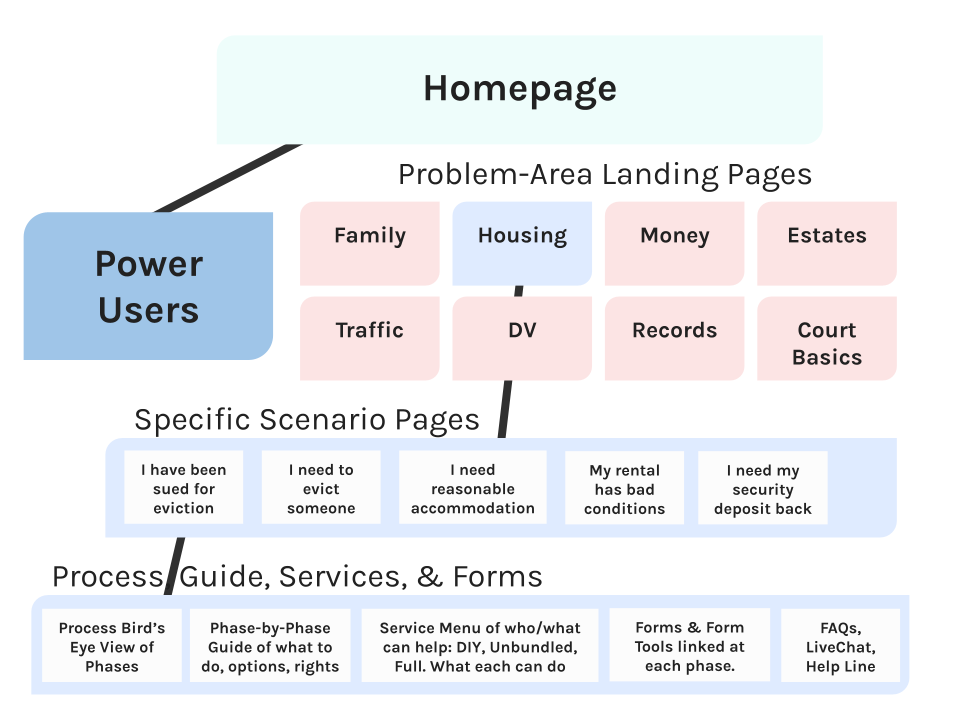
Best practices for information design on legal help websites
Are you in charge of creating a new legal help website? Or are you in the middle of a redesign of an existing one? Then you are likely struggling with this big, unwieldy question: How do we organize all of this legal information so that people can find it & use it effectively? You’re likely…
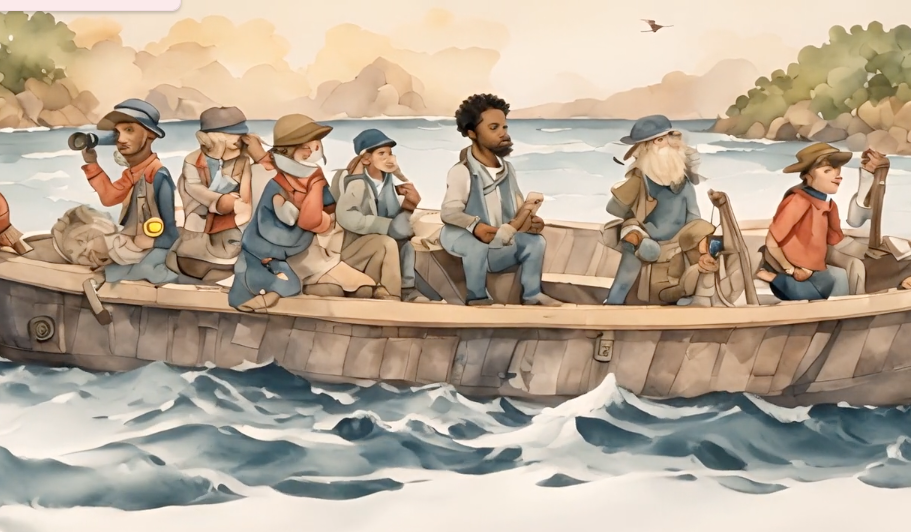
Legal Info in the Sea of Junk
The National Center for State Courts has a new TinyChat video that talks through online legal information strategies in the new era of generative AI. Will there be more low-quality content out there, that people seeking out legal help online will have to wade through? Will legal aid or court websites’ authoritative content get drowned…

Website Redesign Report: ABA Free Legal Answers
This report is from our student group in the Spring 2023 class 806y, Justice By Design. American Bar Association’s Free Legal Answers: User Experiences and Recommendations by Sonya Googins, Justin Iannacone, Kelsea Jeon, Shannon Lee, Ana Ribadeneira, Kevin Wang, June 9, 2023 Table of ContentsIntroductionOverview: User Experience with FLA Touchpoint: Arriving on the Home PageUpdated Home Page Cover…
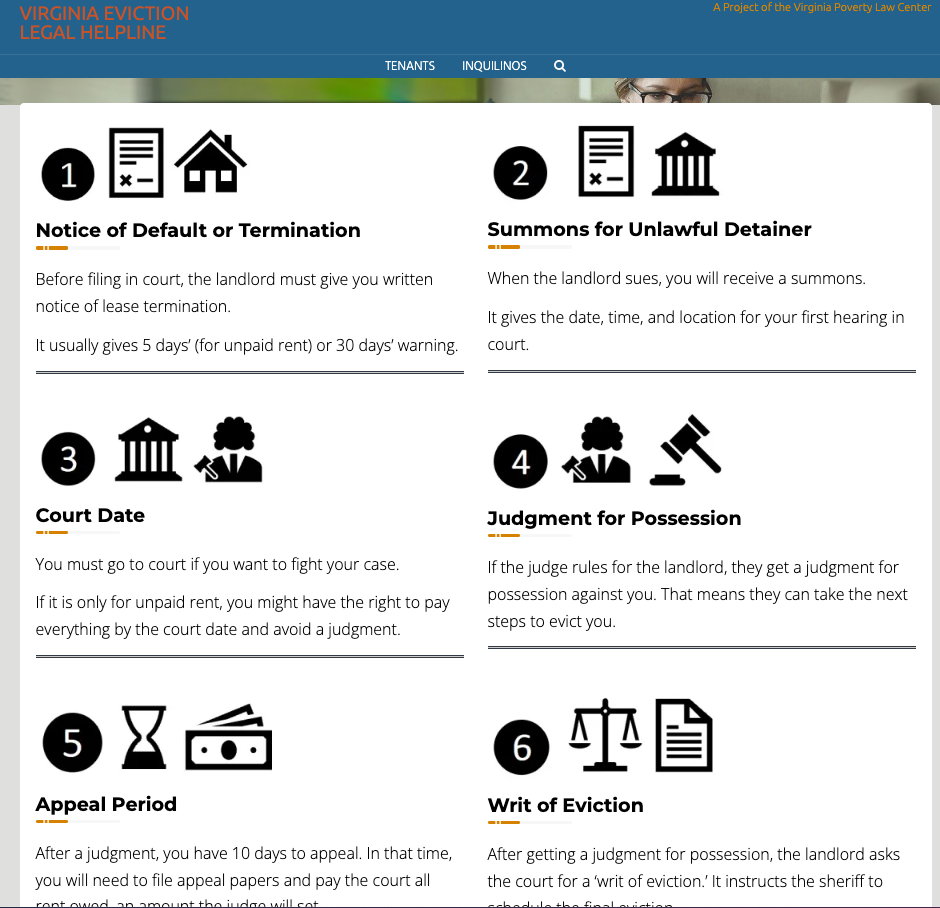
Virginia’s Eviction Legal Helpline website review and strategy
This report is by a team of Stanford University students in the Spring 2023 Justice By Design class. The student team was Gabrielle Braxton, Shirley Frame, Whit Froehlich, and Lavi Sundar. The students conducted a design review and user interviews in partnership with the Eviction Legal Helpline team. The goal of the class was to…
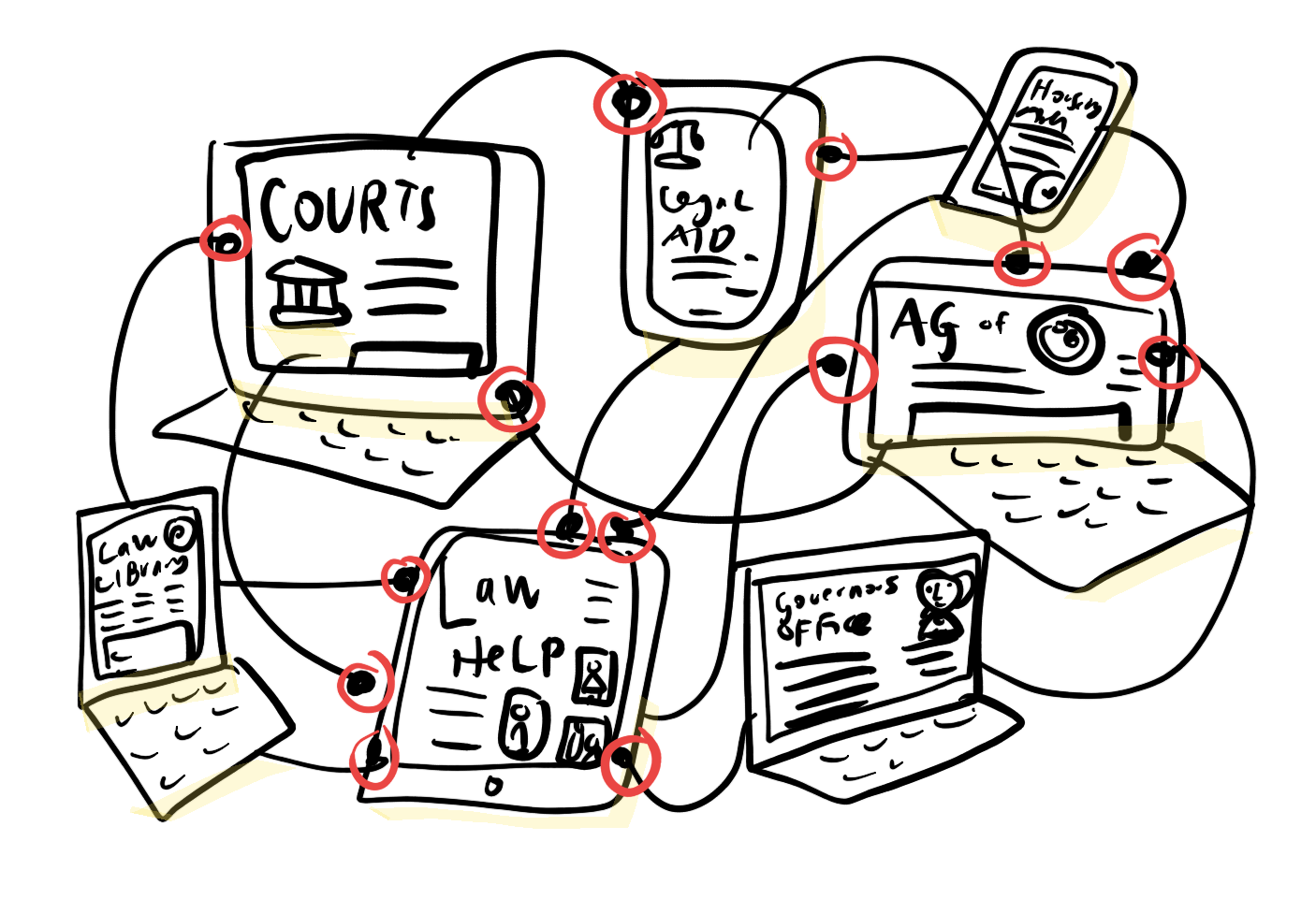
Backlink Strategy for Legal Help Websites
Who links to your legal help website? The more other websites that link to you — especially government or educational ones — the higher your website will climb on search results. This is called a ‘backlink’ strategy. Search engines look to the web of who is linking to who to determine which sites are valuable,…
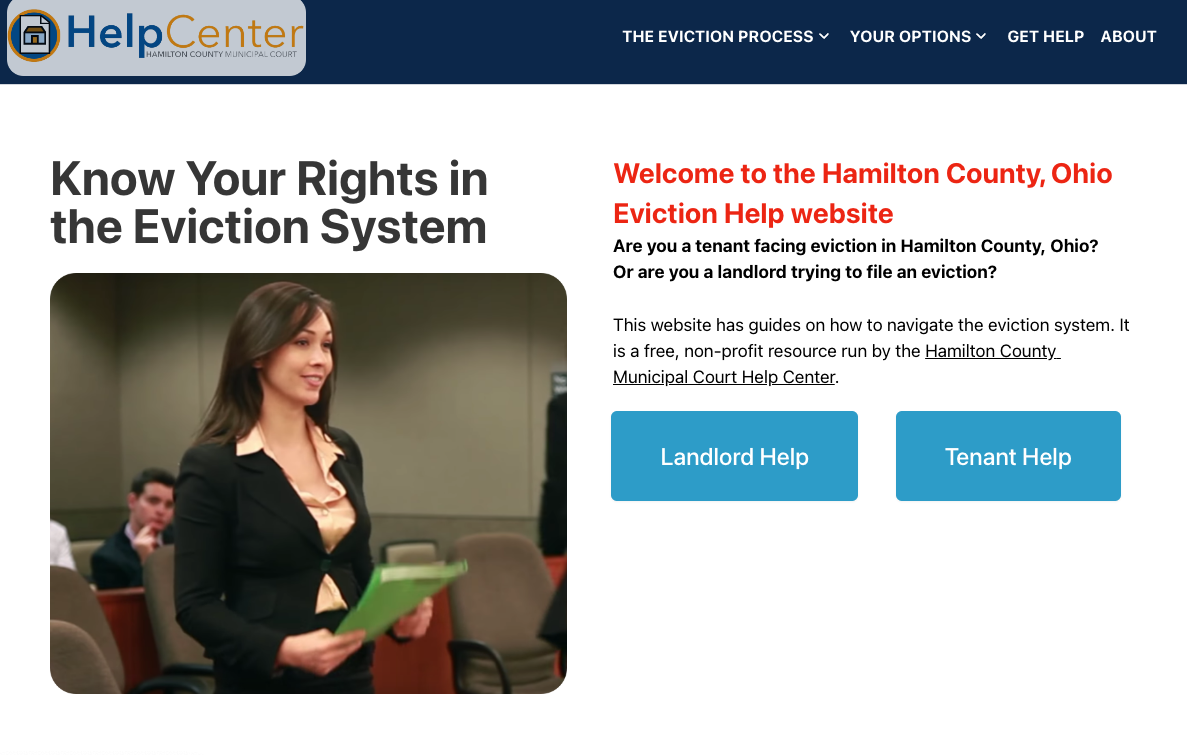
Designing an Eviction Help court website
Our team at Stanford Legal Design Lab collaborated with a court, help center team, and community stakeholders in Cincinnati to build an eviction help webpage. In this video, you can see a walkthrough of the choices we made to make the site as successful as possible in being discoverable, engaging, and usable to tenants and…
Why Invest in a Better Legal Help Website?

People are going online to find help for their justice problems.
They turn to the Internet to find help with money, housing, family, work, and other legal issues.

But can they find reliable, accurate, and actionable help online?
Ideally, search engines & social media will show them accurate, actionable, and empowering information on legal rights & services.

Use the Legal Help Online Dashboard to make quality legal help websites.
This site guides courts, legal aid, and nonprofits on making online resources that people can find & use.
Steps to Making a Great Legal Help Website
Step 1: Make Better Content

Put legal information up that people want when they’re searching online for help. This includes the topics you cover & the format you present it in.
- Use a Style Guide to make more readable, engaging and relevant content for your audience. Use this Style Guide from another legal help site, that you can adapt.
- Update your content to match what people are searching for, and how they like to find help
- Have legal information on popular legal help topics: debt collection, eviction, landlord-tenant problems, domestic violence restraining orders, possible housing contractor scams or fraud, divorce, custody, child support, driver’s license reissue, name change, wage theft, and clearing a criminal record. See a list of all the popular topics & how people search for them at our page here.
- Present this content in the formats people like: draft them as FAQs with questions and answers. Make them into step-by-step guides of actions to take. Lay out a menu of options. See more on how to present your content well.
Step 2: Improve your Technical Performance

Your website’s technical performance will affect if people can use their site — or if Google even shows it to them. If your site is slow, buggy, or mobile-unfriendly, then many people will never visit it — or bounce away from it if they do click on it.
- Explore our traffic & technical quality rankings of US legal help websites to find how your site compares.
- Check your site’s current technical performance by using one of the automated checkup tools to scan your site for problems.
- Check your tech to improve how fast, bug-free, and responsive your website is.
- Work with your developers to deal with any of the problems that the tools flag as slowing you down, making it hard for people to use your site, or possibly loading errors.
Step 3: Get Search Engine Optimized

When someone searches for legal help in your jurisdiction, do they see your website? Is it on the first page of the Google results, or even in the first slot? Or is it buried a few pages deep in the results pages, where few people will ever find it? There are some concrete things you can do to increase your site’s search rank.
- Get Schema.org markup on your site, so that the search bots know what your site is, what topics you offer help on, what jurisdictions you cover, and who to send to your site. Use our free tool to create this markup.
- Link to other jurisdictions’ help pages for visitors who don’t belong on your site, and also increase your site rank through a backlink strategy. Find this index of other legal help pages to link to, by state.
- Contact other government agencies, universities, & non-profits in your region to ask them to link to your site. See more in our Backlinks strategy guide.
- Keep your pages (and copyright) up-to-date, like by updating your footer’s copyright text to the current year, posting regularly, and refreshing your sub-pages.
- Follow our other steps to make your site more discoverable by people searching online.
Step 4: Improve your User Experience Design

Make sure it’s very easy for people to navigate and understand your website. That means a focus on visual & interaction design on your page.
- Follow key design principles to make sure your webpage is user-friendly, low-burden, and helpful to your users. Start with this quick overview on good web design.
- Use these deep-dive field guides to use best practice website components, run user testing sessions, and improve the visual and language accessibility of your websites. Find the deep-dive guides here.
What’s a good legal help website?
Our group at Stanford Legal Design Lab carries out research to evaluate the state of legal help online.
This includes evaluating how search engines perform in connecting people with legal help. It also includes the evaluation of legal help websites.
We have developed a high-level rubric with criteria for evaluating the quality of legal help websites.
The criteria we use to evaluate “what works” in legal help website includes the following 3-category rubric. This rubric should drive toward better websites that build people’s legal capability, promotes high-quality engagement and choice in the justice system, and allows people to participate with little burden or cost to them.
1. Jurisdiction-correct, Actionable, Local information
A legal help website should give a person information that they can rely upon to take action, find services, and start resolving their problem.
This information should not be for another jurisdiction, and thus irrelevant or harmful to the person.
It should not be out-of-date, with legal procedures, forms, rights, or services that would be incorrect to rely upon.
Some news reports have called out examples of legal misinformation online, that might take the form of scams or conspiracy theories.
2. Specific, detailed, actionable information about rights, processes, and services
A website should give a person specific actions they can take to address their problem.
Generic information that describes a problem or legal options at a high level may have some use in establishing a person’s basic understanding of the law.
But far more valuable is a website that tells them groups that they can call for help, local courts and authorities that they can visit to get started on filings or hearings, or local procedures to follow.
The more specific and local the information is, the more it can help a person take quick action to respond to the problem.
Ideally, this high-quality information will build a person’s legal capability. The website should help them understand their problem, form a strategy, take action, and feel empowered. It should make them more likely to participate in the legal process, rather than disengage with it. Read more about legal capability here, to understand this key outcome.
3. Minimal burden or cost on a person to access information about rights, process, and services.
A website should be easy for a person to use, to find the key information they need to begin resolving their issue.
It should have minimal distractions, barriers, and costs that could prevent them from using the site’s information. Ideally, a person should not have to give up data, money, or privacy in order to know their legal rights, procedures, paperwork, and services to help them with their problem.
Read more about administrative burden here, to understand more about this metric that governments use to measure the usability of their public-facing services.
